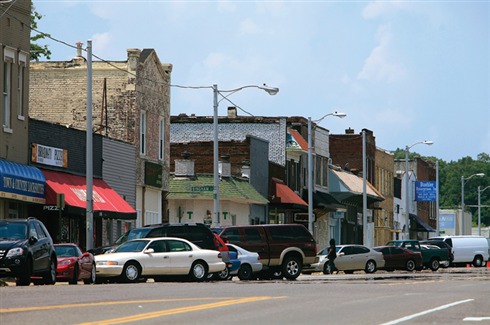 |
| (photo by Lance Murphey) |
by Anna Ellis
Have you ever been in a restaurant, or maybe a house party, and you hear the phrase, “Memphis is just dead….or dying?" Haters. You can spot them so easily from this one small statement. In particular, I hear a lot of people talk about all the abandoned buildings around town; one of my friends on the Book of Faces has a virtual photo album dedicated to the sole purpose of documenting the economic devastation which has wreaked havoc on the commercial building industry in Memphis (i.e. mounds of abandoned buildings). These Negative Nancies love to point out what's wrong with the city, what is not going on, what we lack. This is me taking a stand. This is me saying, “Get wise to the new game, ya haters, you!”
I suppose, to lay out the parameters of the new game one must give a brief summary of the old game. And by “game” we are talking commercial/public development, by the way. So, the old game: a chaotic collage of developers and investors throwing together piecemeal business plans, finding spaces and building without the end user turn-over in mind. In other words, no consideration of wise urban planning. Urban planning has been around for centuries, with Florence being the first well planned urban development. Many cities, such as Paris, Lisbon and Chandigarh have employed urban planning techniques which promote civic engagement.
Memphis always has been a bit behind the curve, but that’s part of the charm, isn’t it? There was no entity at the founding of our city which fostered collaboration between the developer, government, end user and public. Until recently, the old game was stagnant and well ingrained into the practices of the building industry. But a few key elements have come into play within the past five to ten years which have made the old game out of date, and almost impossible to play. Around the late 1990’s, Memphians started that dreaded “first step": admitting there is a problem. Three key entities have been put into place since then, for the purpose of administratively steering the course of design in a new direction. Below are descriptions of the new-ishly appointed commissions, taken from the memphistn.gov website (which seems to be down this morning, which is not our problem. - Ed.):
- “The Center City Development Corporation was chartered by the City of Memphis, Shelby County, and the State of Tennessee to promote redevelopment and combat the deterioration in the Central Business Improvement District (CBID). Additionally, the CCDC acts to expand employment opportunities, increase personal income, establish and finance business ventures, coordinate governmental planning, promote housing development, and promote the common good and general welfare of the Center City.”
- “The Design Review Board serves to make recommendations regarding regulations with respect to signs and other public and private improvements within the Central Business Improvement District (CBID). The DRB is also charged with developing and implementing the CBID sign ordinance.”
- “On April 29, 1998, the Tennessee General Assembly enacted the Community Redevelopment Act of 1998. This enabling legislation gave Memphis and Shelby County the exclusive authority to establish a Community Redevelopment Agency with all of the powers necessary to plan, finance and implement major redevelopment projects. The Memphis and Shelby County Community Redevelopment Agency (CRA) was established by the Memphis City Council and Shelby County Board of Commissioners by in 2000. The CRA was established for the purpose of improving the quality of life through the prevention and elimination of slum and blight and providing affordable housing for low to moderate-income families within Memphis and Shelby County. The CRA is the only joint City and County entity authorized to finance and implement major redevelopment activities. The Memphis and Shelby County Division of Planning and Development serve as the Staff to the CRA Board of Directors, which is composed of seven members, appointed by the City and County Mayors.”
These three administrative bodies seek to promote community collaboration with the developer. I have personally have sat through meetings at the Design Review Board in which the developer, the end user and members from the community “hashed it out”. The new goal is to give everyone a fair say, and to work together to come up with the very best possible outcome. This transparency and collaboration are just as contagious as the negativity in the past has been and this is the foundational slab of the "new game" for urban planning in Memphis. The new game is collaborative, communal and comprehensive. All over Memphis I see building projects in which this style of development was applied successfully. Below is a list of projects which have all played by the rules of the new game:
East Memphis
- Shelby Farms Woodland Discovery Playground
- FedEx Institute of Technology
- Cancer Survivors Park, Audubon Park
- The Levitt Shell, Overton Park
- Uptown Habitat for Humanity communities
- Broad Avenue
- The Beale Street Landing
To remember the new game, haters, stick with the three C’s. If it is Collaborative, if it’s Communal and if it is Comprehensive – it’s a product of the new game plan, and you should get involved. It sure beats posting pictures of abandoned buildings on Facebook.
Anna Ellis is a Memphis interior designer and finance guru of some sort. She makes really good roasted stuffed squash, or whatever that was a few weeks ago. I'm sure the recipe had a fancier name.
No comments:
Post a Comment